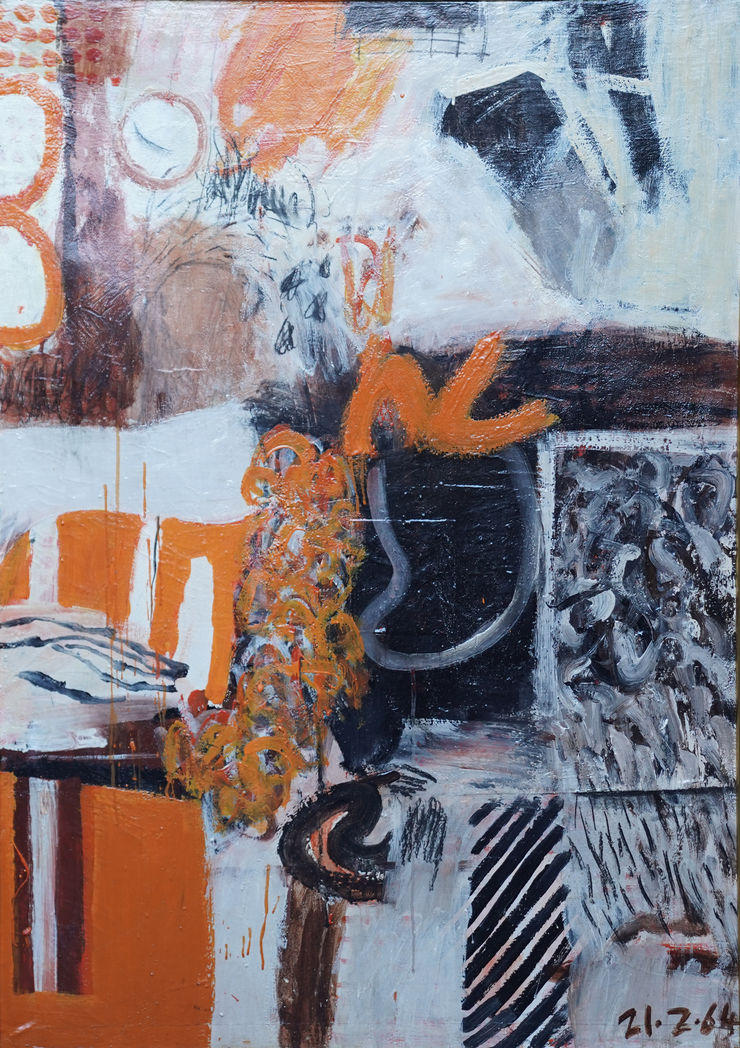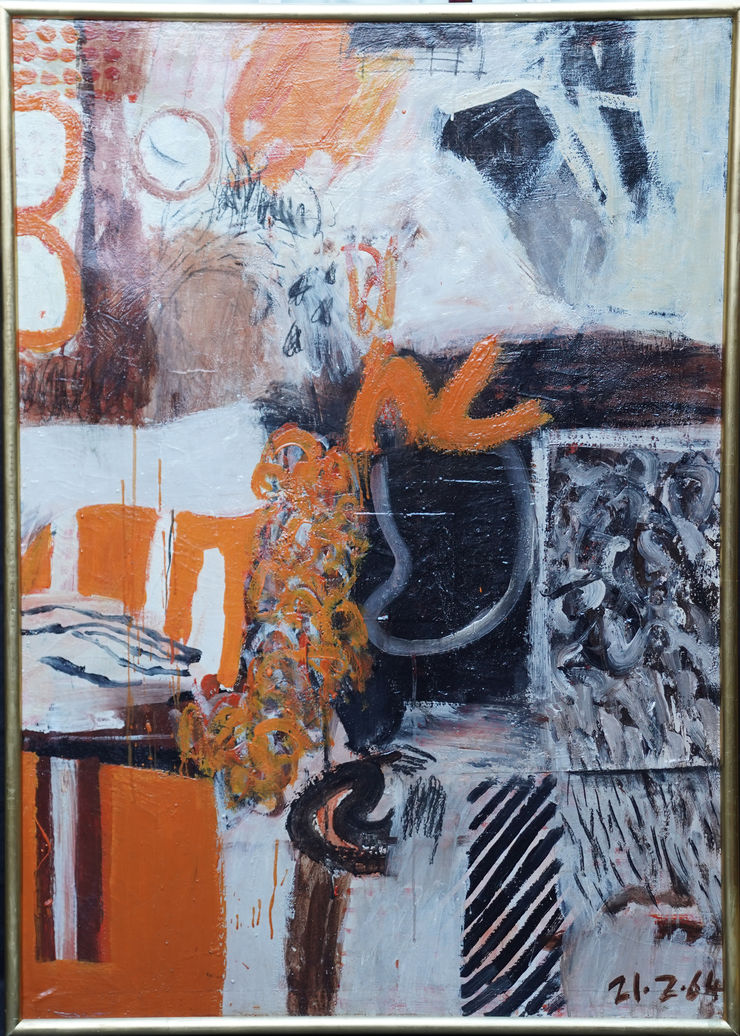Jack Knox (1936-2015)
| Artist Name | Jack Knox (1936-2015) |
|---|---|
| Title | Scottish Abstract |
| Description | This very striking exhibited Scottish Abstract oil painting is by influential Scottish artist Jack Knox. Painted in 1964, it is a vivid mix of autumnal colours, textures and brushwork that work perfectly. A brilliant example of his work from the early sixties and which was exhibited at the Royal Scottish Academy in 1965. Titled and dated 21.2.64 lower right. |
| Provenance | Exhibited Royal Scottish Academy, Exhibition 1965, Edinburgh. |
| Medium | Oil on Canvas |
| Size | 36 x 51 inches |
| Frame | Housed in gilt sixties surround frame, 53 inches by 38 inches and in good condition. |
| Condition | Good condition. |
| Biography | Jack Knox RSA (1936-2015) was one of the most influential artists to work in Scotland in the second half of the twentieth century. Born John Knox to a family of tailors in Kirkintilloch, Knox studied at the Glasgow School of Art (1953-57) where his drawings were noted for their mature draughtsmanship. After graduating, Knox went to Paris to attend the atelier of Cubist artist, André L’Hȏte. During his time in Europe Knox digested the various art movements of the moment, including Surrealism, Tachisme, Colour Field and Pop Art. Visiting the great museums, he was particularly interested in Analytic Cubism and Georges Braque’s intimation, rather than description, of object. He also went to Brussels to visit the first major show of American Abstract Expressionism in Europe. He returned to Scotland eager to establish his own style, drawing on everything he had seen in Europe. In 1960 the Glasgow Herald presented an exhibition during the Edinburgh Festival of young artists from the west of Scotland. Knox was selected to show alongside George Devlin, Carole Gibbons, Anda Patterson, Douglas Abercrombie and Duncan Shanks. Knox’s paintings included in the exhibition, undertaken whilst he was living and working in Rothesay, show the influence of the Abstract Expressionists and Colour Field painting during these early years of his development. Responding more enthusiastically to the optimism of American Abstract Expressionism than to the more muted French variation, Tachisme, Knox expressed his opinion that ‘this was art starting all over again’. Knox’s outlook would remain emphatically international throughout his career, drawing on divergent, multifarious influences. He would go on to participate in exhibitions in Chicago, Warsaw, Brussels, New York, Düsseldorf, Vienna, San Paolo and Sarajevo. In 1965 Knox moved from Rothesay to Carnoustie and became a lecturer in the Department of Drawing and Painting at Duncan of Jordanstone College of Art in Dundee, where he worked alongside Alberto Morrocco and David McClure. In the immediate years after leaving art school, Knox’s palette was restrained and careful but during this period he incorporated PVA into his paintings, employing the speed and confidence needed to work with the material. Knox’s imagery during the 1960s was strong and individual but focused on subjects found in his immediate domestic surroundings. Recurring shapes and motifs emerge and everyday objects obtain philosophical importance. In 1966 Knox has his first major solo exhibition at Aitken Dott’s Scottish Gallery, Edinburgh. Reviewing the exhibition in the Glasgow Herald, Cordelia Oliver wrote that ‘at times there is a sense that everything is rushing off at tangents so that only the firm canvas edge holds the warring or escaping elements in place’. Knox’s style developed rapidly over the course of his career. One critic remarked that he initially intensely disliked Knox’s work but, just as he began to like it, he found that the artist had changed to another style. Every time he warmed to Knox, the critic complained, he had changed his style. Despite the frequent stylistic shifts, Knox’s output across the decades is united by an urge to make connections between elements which are seemingly unrelated and to let ‘things coexist on the canvas’. Standing outside of art movements, Knox took his own path along his stylistic journey. One of the most important developments in Knox’s style came about in 1972 when he took a group of students to Amsterdam and saw an exhibition of Colour Field painting at the Stedelijk Museum, including paintings by Morris Louis and Kenneth Noland. Although it had been formative in his early career, Colour Field now seemed old fashioned to Knox and he left the exhibition dissatisfied. During the same visit, he was revived at the Rijksmuseum by the seventeenth-century Dutch still lifes before going down to the museum café and, ironically, finding inspiration in the cheeses, hamburgers and beer for sale. Returning home, Knox began to paint scenes of food and drink with a sturdy two-dimensionality, adapting the Dutch realist tradition to anti-Modernist ends. Attracted to the opposition of textures in these scenes, Knox painted baskets of fruit with the woven material of the basket contrasting the smoothness of the fruit. This interest in domestic still lifes would continue for the rest of Knox’s life. He obsessively re-used objects to present a cornucopia resplendent with vitality and vibrancy. In 1981 Knox moved back to the west coast and was appointed Head of Drawing and Painting at Glasgow School of Art. He worked in the spacious studio assigned to his post in the historic Mackintosh Building. Knox placed particular importance on careful drawing and instilled this in his students. He is remembered fondly by a generation of artists he tutored, a group of whom would later be dubbed the New Glasgow Boys. Knox taught at GSA until he retired in 1992. In 2004 he set up home and studio in Broughty Ferry, near Dundee, with his wife, Margaret, where he continued to work until his death in 2015. |
| Price | £14000 |

